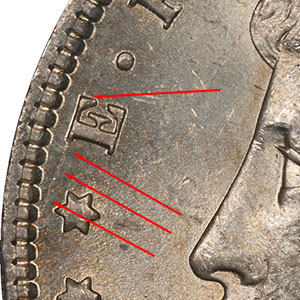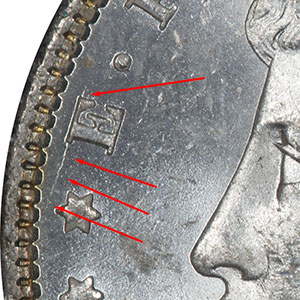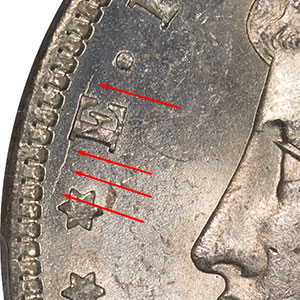
May 2017 - Welcome
Sources
Search
Contact
Home
Welcome
Click on year to expand
2022
2021
2020
2019
2018
2017
2016
2015
Welcome
Morgan Dollar "Fingerprints"?
Morgan Dollar "Fingerprints"?
![]() The new VAM identified by Leroy Van Allen is VAM 72 - Doubled 18, Polished Forehead. It shares Obverse Die 42 with VAM 64. That information has now been added to the web site and to VAMworld.
The new VAM identified by Leroy Van Allen is VAM 72 - Doubled 18, Polished Forehead. It shares Obverse Die 42 with VAM 64. That information has now been added to the web site and to VAMworld.
![]()
![]() Revisions identified by LVA to VAMs 9 and VAM 20 have been made here and on VAMworld.
Revisions identified by LVA to VAMs 9 and VAM 20 have been made here and on VAMworld.
![]()
![]() The recommended combining of VAMs 1E and 53. Interestingly this will make the combined VAMs 1E/53 the most populous in our collection.
The recommended combining of VAMs 1E and 53. Interestingly this will make the combined VAMs 1E/53 the most populous in our collection.
We believe that this collapsing of VAMs means that VAM 53 is the most common of all 1881-O VAMs. Fortunately we have learned that VAM 53 has a unique reverse die crack through the mint mark and it is easily recognized through this "One and Done" characteristic.
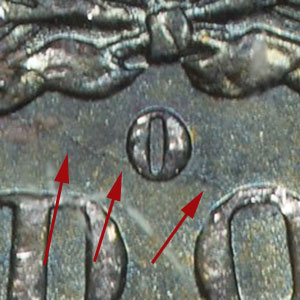
Once you know this little feature screening them on on-line sites becomes easier and there are a lot of them.
![]()
![]() VSS has a submission of roughly 80 coins that includes the ones listed above that need to be labeled after the return from LVA. We got word on April 29th that they are in the mail to us, so as soon as the images arrive we will add them to the web site.
VSS has a submission of roughly 80 coins that includes the ones listed above that need to be labeled after the return from LVA. We got word on April 29th that they are in the mail to us, so as soon as the images arrive we will add them to the web site.
We are still working on our 100 coin bulk submission and now have 98 of the coins we need for submission. This one will be headed to VSS as soon as the other 80 come back.
![]()
![]() Last month we joined the discussion at CoinTalk.com for the first time and it continues to be an interesting place to hang out and learn a thing or two. Give it a try, but also become a sponsor. The membership fees are nominal and every little thing we do supports coin collecting.
Last month we joined the discussion at CoinTalk.com for the first time and it continues to be an interesting place to hang out and learn a thing or two. Give it a try, but also become a sponsor. The membership fees are nominal and every little thing we do supports coin collecting.
Morgan Dollar "Fingerprints"?
This topic has some interesting connotations and could lead us into a multi-year study on dies, but a worthwhile study. Fingerprints are unique to each of us and provide a proof positive way to identify us because we leave them behind as evidence wherever we go.
We once saw an interview with the noted Civil War historian and author Shelby Foote. In the interview he hypothesized from his research that all our lives can be roughly divided into thirds. And that in each third there was some event that shaped the remainder of our life. But, we do not know how to divide up those thirds until our death.
And that brings us to Morgan Dollar dies. Whether or not we know the dividing lines, all dies have an early, middle, and late die state. Now this can be a good topic of discussion since theoretically a die could be placed into use, never have a problem, and ultimately be retired and all states would look the same. A die could also be placed into use on the last day of production and the die states be divided into hours and not days.
![]()
Die Life
But a more logical measure of life for a coin die is probably coins struck and not wall clock time. If a die struck 30,000 coins then logically events in the first 10,000 coins will influence the last 20,000. But we lack the data to know exact die life, so our study will out of necessity be less exact with regard to actual die life as measured by production. Perhaps at some future date die life will be known, but it is doubtful.
In the 1800s the process of refining steel and repeatedly annealing and tempering dies and hubs was manual and not as exact as today. These processes often produced dies with inherent weaknesses that began to show as the die was used. But the appearance of these weaknesses was an unpredictable event, and the recognition of the problem also somewhat haphazard. In theory, with perfect quality control coins with such defects would have been pulled and melted. But inspection was by hand and eye, and a die crack was not easily seen.
And so we launch our study of die cracks and associated dies, and by extension VAMs. This is an open-ended look at the topic since there can be new discoveries at any moment in time and new associations that might change our perception of die state. We also start with the obverse dies and will note the pairing with the reverse die when appropriate.
![]()
Some Boundaries
As with all our work, unless we have the coin in hand as a part of our collection we will not include it.
- We want to be able to examine each coin under the same conditions to provide proof of features.
- We also want the reader to be able to go to those same coins and examine them using our VSS quality photographs.
- We will not include all dies because not all dies show die cracks, certainly not all VAMs in our collection.
- We will only include Mint state coins in the analysis since below Mint state the introduction of surface damage can come from foreign sources.
- We plan for this to be somewhat random as we go back through our collection and find dies of particular interest.
All data will be added to our web site but all of this will take time.
Since VAM 53 - Doubled 18, Pitted Ear has proven to be our most common we think it is appropriate that we start this study there. This VAM uses Obverse Die 34 and so far it is unique to this VAM. We know we can identify the VAM 53 from the reverse die crack, but what about the obverse?
As of this analysis we have 52 examples of VAM 53, and 39 of those are Mint State coins. So there is plenty of material to examine. So far there seems to be only one die crack present on the die in our examples, but this crack exists in different lengths as die wear progressed. Also, this crack is visible down as far as grade AU 53 on some examples outside this discussion.
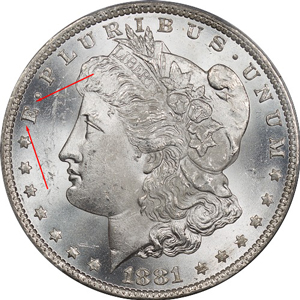
Earliest State
In the earliest state for Die 34 there is no crack present. So obviously the absence of a die crack cannot be used to either identify or eliminate Obverse Die 34 from consideration.
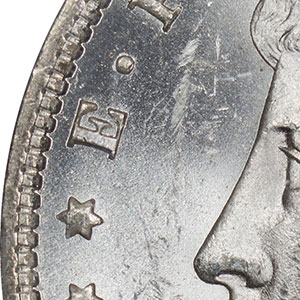
First Appearance
There are a number of coins where the die crack appears below the E only or may extend very slightly at the top of the E.
Next To The Last Appearance
Finally the crack begins to grow and extends beyond the top of the E much further than in the examples above indicating that the crack was becoming more prevalent.
But Then We Found This
Looking at a particular die in this much detail can reveal some facts overlooked in other analyses. Our discovery was that out of the 39 Mint State coins, 5 were lightly clashed. The clashed coins were not grouped by grade and all exhibited the latter state of die crack.

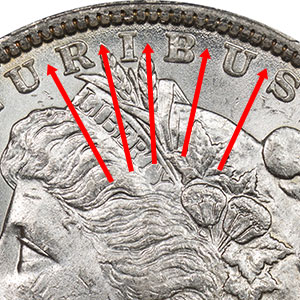
Four of the five coins show signs of stress toward the rim as if the die is starting to fail.
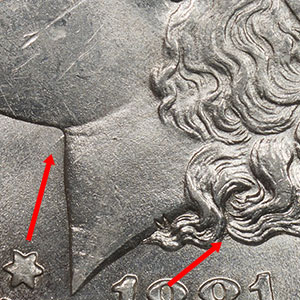
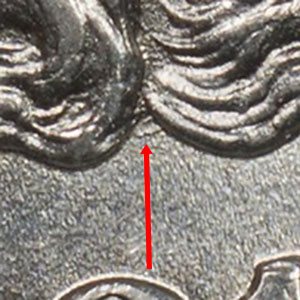

The signs of the clash are faint, but observable and there is a small gouge or other mark on these coins that is lacking on those that are not clashed. This feature appears in the lower hair vee.

And then on one clashed Mint State 65 coin we believe we have both clashing and letter transfer. This one deserves further analysis to see if it is a sub-variety.
In summary, Obverse Die 34 can be identified by its die crack through the E in the Legend when it is present. The length of the die crack does advance with wear and ultimately appears with signs of die fatigue. Also the clashed examples in our collection show the advanced die crack, so the clash was not the source of the crack.
Since we have only one VAM associated with Obverse Die 34 at this point, then it follows that VAM 53 can also be identified by this obverse die crack.
New Resources Found
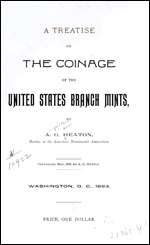 A Treatise on The Coinage of the United States Branch Mints, A. G. Heaton. Many of us take for granted the collection and exploration of Branch Mint differences. But in the early days of collecting Branch Mints and Mint Marks were not collected. This publication, published way back in 1893, is considered the first to introduce and generate interest in the subject among numismatist. Although the format of the publication looks like many government publications of the day, we assume it was published either privately or by the American Numismatic Association.
A Treatise on The Coinage of the United States Branch Mints, A. G. Heaton. Many of us take for granted the collection and exploration of Branch Mint differences. But in the early days of collecting Branch Mints and Mint Marks were not collected. This publication, published way back in 1893, is considered the first to introduce and generate interest in the subject among numismatist. Although the format of the publication looks like many government publications of the day, we assume it was published either privately or by the American Numismatic Association.
We were made aware of this through the E-Sylum monthly newsletter and it is interesting reading. The link in their newsletter is to a copy that originates with the Library of Congress and is downloadable as a PDF. At only 54 pages it is easily read and informative about how collectors were made aware of the existence and importance of identifying Branch Mint production.
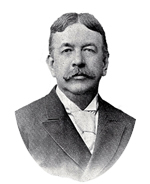 Augustus Goodyear Heaton was born in 1844 and died at the age of 86 in 1930. Among other things he served as the third president of the American Numismatic Association from 1894 until 1899. Apparently he was also a painter and poet of some notoriety.
Augustus Goodyear Heaton was born in 1844 and died at the age of 86 in 1930. Among other things he served as the third president of the American Numismatic Association from 1894 until 1899. Apparently he was also a painter and poet of some notoriety.
We also read that this same information was published in a book by Q. David Bowers and think that it probably a more understandable format. This is very interesting reading, but to us difficult to follow because there are no illustrations. You really need to have some image references at hand to follow the reading.
![]()
Treasures of the Spanish Main: Shipwrecked Galleons of the New World, John Christopher Fine.
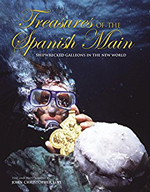 Published in 2006 this is obviously not new information, but an entertaining and easy to read book on shipwreck discoveries. This topic seems to be one we have become hooked on right now and probably because there is a little treasure hunter in us all. The Spanish wrecks along the east coast and further south in the Caribbean are always fun to think and speculate about.
Published in 2006 this is obviously not new information, but an entertaining and easy to read book on shipwreck discoveries. This topic seems to be one we have become hooked on right now and probably because there is a little treasure hunter in us all. The Spanish wrecks along the east coast and further south in the Caribbean are always fun to think and speculate about.
![]()
If you can do nothing else with your collection at a point in time you can always read. Superior knowledge of any subject always pays dividends in the long run.
"Reading is to the mind what exercise is to the body." - Richard Steele
Getting Started
Collecting The 1881-O
The 1881-O VAMs





















